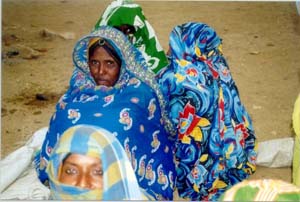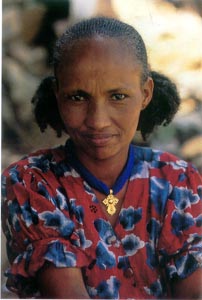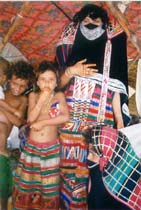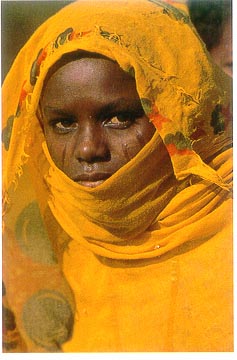THE PEOPLE OF ERITREA
For thousands of years Eritrea has been the crossroads of ancient trading routes from Asia, Arabia and Africa and home to a various ethnic groups practising different lifestyles, religions and traditions.
Today it is accepted that there are nine distinct ethnic groups in Eritrea: the Cushitic Beja, Saho, Afar and Blin; the Semitic Tigre, Tigrigna and Rashaida; and the Nara and Kunama. The Beja of the Nubian Desert
The Beja, known to the Greeks as the Blemmyes, have lived along the Red Sea coast for thousands of years. Their life is harsh to an extreme and, in many ways, far from the modern world. The great majority of Beja are semi-nomadic pastoralists, raising camels for which they are renowned. The majority live in the Nubian Desert straddling the border of Sudan and Eritrea while a few live in the more fertile area south-cast of Agordat and practise agriculture. The people are basically organized simply in patrilineal descent groups. All adult men debate the communities' concerns -women are excluded.
Beja women are particularly reticent in front of strangers, and keep their lovely gold ornaments hidden from public view with their muslin veils. The nomadic Beja live in small encampments, in houses made of mats and hides over wicker frames. These are easily dismantled and carried by camels when the people move in their perpetual search for water and fresh pastures. In some areas the language of Beja is giving way to Tigre, as wealthy Beja speakers tend to marry Tigre women - and it is mothers who usually bring about language changes in families. | |
The Bilen, Farmers of the North
South of the Beja, around the town of Keren, a small enclave of central Cushitic speakers is called the Blin. Traditionally farmers, they use oxen to pull their ploughs.
Their social structure is organized by kinship groups. Like the Beja language, Bilenn is slowly being displaced: by Tigre and Tigrigna due to intermarriage, economic and social interactions and, to a certain extent, by Arabic through its use in schools. The Ministry of Education is doing all possible to cultivate and develop mother tongues. A few Blin academics are also writing a monolingual Blin dictionary, novels, grammar and primer to safeguard the language. | |
The Pastoralist Saho
In the first millennium, eastern Cushitic speakers came down from the highlands and evolved a pastoral way of life adapted to the barren lowlands. Gradually they developed into the peoples known today as the Saho and the Afar.
The Saho inhabit the coast and the hinterland around Massawa, moving up and down according to the season. Towards the end of April, when the rains in the lowlands stop, the Saho leave the coastal Semhar area and trek with their livestock Over the centuries a mutually beneficial relationship has developed between the Saho of the highlands and the Tigrigna. The Saho not onlytend their own cattle, but also those belonging to highland Tigrigna, from whom they receive grain in exchange. Gradually this has led to groups of Saho speakers settling in the highlands among Tigrigna speakers, so that there are many villages in AkeleGuzai where Saho and Tigrigna are mixed. The Saho who have settled in the highlands have gradually become small-scale farmers, as their ancestors were before they descended to the coasta thousand years ago. Honey is an important part of the Saho diet and bee-keeping prestigious. Even urbanized Sahos engage in bee-keeping. The Saho are organized in patrilineal descentgroups. Each of the seven sections has a traditional leader, called rezanto, but his authority depends on theagreement of the all male assembly.. The rezanto's role was primarily that of a military leader in time of war. The Saho relish their warrior reputation. Previously one section escorted trade caravans between central Ethiopia and Massawa, and were handsomely paid for their military protection. | |
The Afar, Defying the Danakil Depression
The Afar live in the almost uninhabitable Danakil Depression and the hills along the Red Sea coast, extending into Djibouti and beyond. Most of thearea is scorched, barren desert.
The Afar are pastoralists who have adapted to a particularly inhospitable environment. Although divided by the frontiers of three states, they roam about quite freely with their camels and goats, living in hemispherical houses, made of a framework of branches covered by hides and woven mats, which are easily transported by their camels. They also use their camels to carry to the highlands the slabs of salt which they mine from the long dried salt pans in the area --a centuriesold trade. In the few oases of the Afar territory, the people cultivate maize and tobacco. In some highland areas they have settled and live in stone houses or in caves hewn out of soft rock. Along the coast, some engage in fishing and many men work, at least for a while, as sailors on merchant ships The Afar are a typical segmental society, organized patrilineally. Their oral literature reflects their esteem for military prowess and they have a whole repertoire of war chants. But as a reflection of their primarily pastoral life, they extol, above all, the merits of the camel. | |
The Congenial Tigre
The three Semitic languages spoken in Eritrea are Tigre, Tigrigna and Arabic. Tigre and Tigrigna are closely related to each other and to the ancient language of Ge'ez.
In Eritrea, the Tigre live in the Northern Red Sea, Anseba and Gash Barka regions. Traditionally the Tigre have followed a nomadic, pastoral way of life similar to that of their northern Cushitic neighbours, the Beja. There has been a close relationship between the two groups and as pointed out -many Beja speak Tigre as a second language. Indeed, some groups have adopted it as their native tongue. Some Tigre practise agriculture, and many are sedentary for some months each year while they cultivate maize, durra (sorghum) and other cereals. When the crops are harvested, they move off again with their animals to the dry-season grazing grounds. When the herders descend to the valleys seeking fresh grass for their stock or when they climb up the hills on the plateau, most family members want to go along. Even if they could stay behind in the small villages where there are permanent buildings, the old and the sick insist that they travel with the group. The household goods and provisions are transported by camel which otherwise only carry sick people or new brides.
The social life in these small, self-contained, semi-nomadic communities is cordial and warm a good reason why no one wants to be left behind.
Tigre groups traditionally have a hierarchical social structure with a small aristocracy known as shemagille ruling the bulk of the Tigre. despite this, social relationships tend to be relaxed. Tigre children are brought up in a liberal manner and from an early age participate in almost all family discussions and communicate without shyness or inhibition. Corporal punishment is extremely rare and the children themselves rarely get into physical fights. Tigre oral literature is highly elaborate and includes fairy tales, fables, proverbs, war cries, legends, customs, poems, songs relating to different Tigre tribes, riddles, funeral dirges, supernatural beliefs, stories about battles of bygone days, traditional knowledge, stories about swords and similar pieces.
The Tigre are famously fond of singing and dancing. In the evenings young men and women often get together, beat the drum, play the mesenko (a kind of guitar), clap their hands and perform various dances.
When groups of related families come across fresh pastures and waterholes, they let their donkeys, camels, cattle, sheep, goats and dogs drink first and then pitch their half-round tents and arrange their mats, skins and cloth. They lead the animals to pasture then serve up food, often consisting of millet porridge with curd. Thereafter, the whole group usually sings and chants and dances until early morning. Greetings in Tigre society are particularly important. Without postal services, radio, television, newspapers or telephones the ceremonial 'What have you seen? What have you heard?' communicates essential information. In times such as the 30 years War of Liberation, it might spell the difference between life and death. | |
Tigrigna, Habesha of the Highlands
About half of Eritrea's total population are Tigrigna speakers. Mostly farmers, they plough the densely populated land of the highland plateau. In referring to themselves, their language or culture, Tigrigna speakers use habesha, which was anglicized to the word Abyssinia.
| |
Rashaida, Recent migrants from Arabia
The Rashaida were the last of the Semitic peoples to arrive in Eritrea, in the middle of the last century. It was the most recent wave of the age-old migration of peoples from the Arabian peninsula to the Horn of Africa.
Their original homeland was the Hejaz where a losing battle with other Arab groups forced them to migrate across the Red Sea to the Nubian Desert, that straddles the border of Eritrea and the Sudan. Here they settled, surrounded by Beja and like the Beja, the Rashaida live by and for raising camels. Organized in patrilinear clans and lineages, they are fiercely independent. They marry only among themselves and so far have retained their distinctive culture. | |
Kunama, an Ancient Cultural Heritage
Two very different peoples, the Nara and Kunama, inhabit the Gash Barka area, living in the western lowlands bordering on the Sudan.
The Kunama are thought to be the aboriginal inhabitants. They are primarily farmers, tilling the soil with simple hoes to grow a variety of grains and vegetables, and they also engage in some hunting. But the focus of their interest is their cattle, which are equated with wealth and prestige.
Kunama society is democratic. The elders, who are given high prestige, make the important decisions, through endless discussions under shady trees.
The Kunama social structure is matrilinear, descent being reckoned through the mother, and children inheriting from their maternal uncle. Young men and women socialize without restrictions. Adolescent boys go through certain initiation rites, during which period they are instructed in the techniques of hunting. Once they are considered men they are free to marry - really free, as young people choose their own marriage partners. Social life is very cordial, which may explain why Kunama so dislike being away from home. Educated Kunama are known to have turned their backs on urban centres and returned to the warm social life of their rural homes. Much of the farm work is done by cooperative effort and, once the day's work is over, they relax with feasting and dancing Renowned dancers, the Kunama have developed more than 25 different dance forms. These are often re-enactments of historical events. During the War of Liberation, soldiers from almost all ethnic groups in Eritrea used to fight, study, build and dance together, which led to the popularization of Kunama dances. | |
The Nara, Farmers of the West
|
The People of Eritrea
Subscribe to:
Comments (Atom)







No comments:
Post a Comment